North Vietnam; Ho Chi Minh in front of country outline; 1951; (Michel Nr. 4A-6b); Stamps that were a bit more sophisticated than the fairly primitive HCM set from 1949/1950 but were also produced at Viet Bac Central Printing Works in Tuyen Quang. Michel initially listed the issuance date only as 1951/1955 but the latter number was clearly a mistake as these stamps were still issued in “Dong Duong” currency (first issued in aluminum coins in December of 1945) as evidenced by the fact that they were re-released with overprints of 10dNH and 20dNH in October of 1954 that mirrored the devaluation of the “Dong Duong”currency by 10:1 (into National Bank of Vietnam Dong Ngan Hang) that took place on May 6th, 1951 (according to Government Decree 15/SL). So, clearly, these stamps with “Dong Duong” nominals must have been issued prior to May 12th, 1951 as otherwise they would have already been nominated in “National Bank of Vietnam Dong Ngan Hang”. According to https://english.vietnamnet.vn/fms/special-reports/83771/over-600-year-history-of-vietnam-banknotes.html the currency was exchanged over a period of 20 months. This meant “Dong Duong” notes were still valid and in circulation until at least February of 1953. During that period these stamps were hence sold at face value in the old “Dong Duong” or at one tenth of face value in the new Dong Ngan Hang. The first stamp already issued in Dong Ngan Hang was the 100D Production and Thrift stamp that was released on July 13th, 1953. The 100 Dong brown comes in brown and lilaq-brown and the 200 Dong value in brick-red and carmine. The stamps below are in the color sequence: brown, lilaq-brown, green, brick-red and carmine. The lilac-brown and the carmine values representing the first printing are much rarer than the others of the second printing, though catalogue makers do not distinguish pricing between the various color options.
100D green, 100D brown and 200D in brick-red perforated in blocks of four: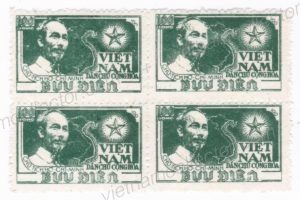
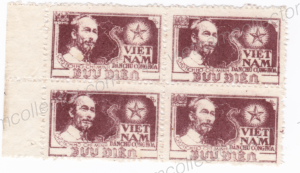
Postcard of Ho Chi Minh in 1950 caressing a young child.
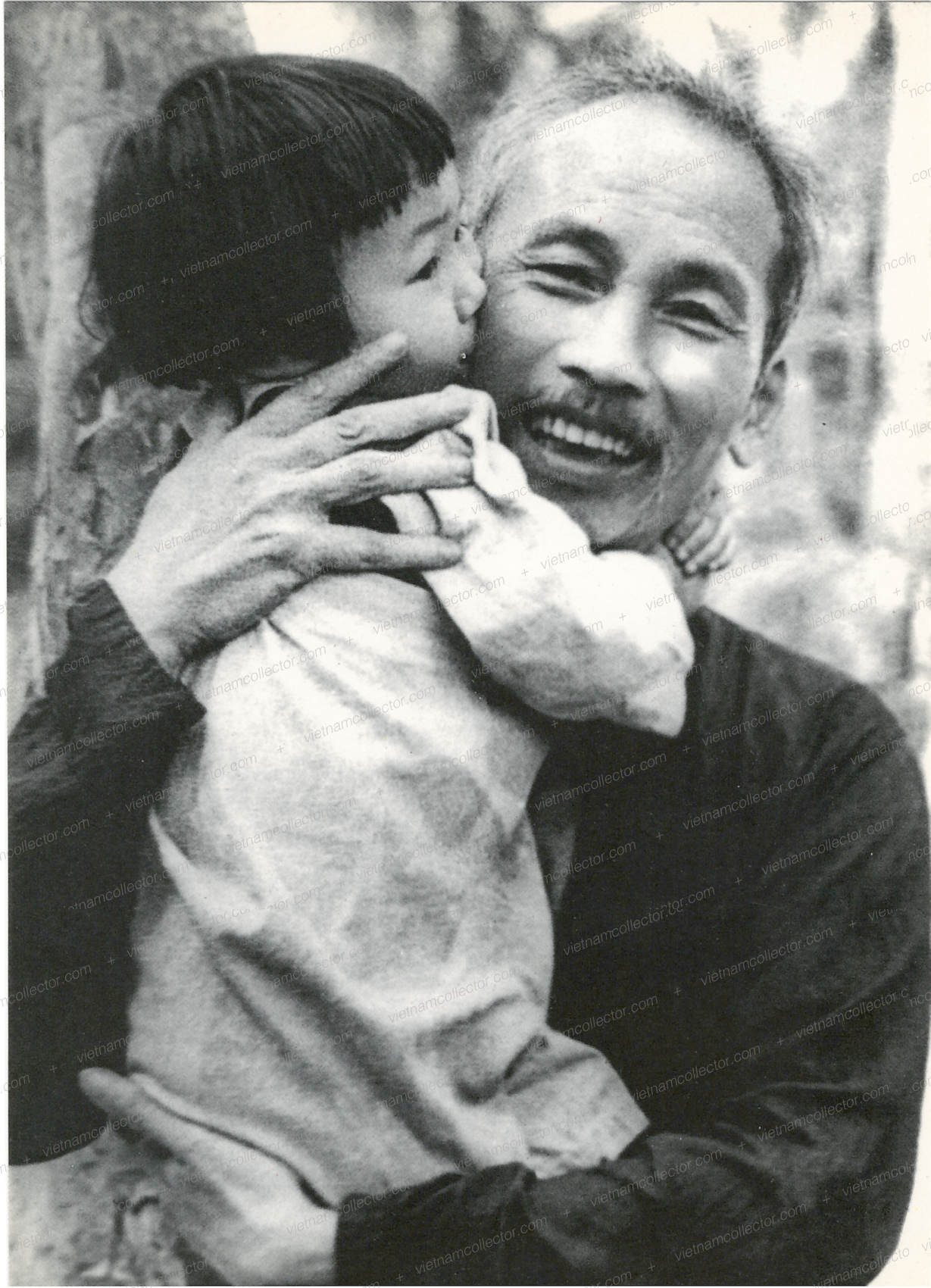
The stamps were released also imperforate. This was sometimes a necessity as the perforation was applied by hand. Two people, using two bamboo-sticks in which a large number of small nails had been inserted, would manually press down on about 10 sheets at a time. For expediency this process was sometimes omitted.![]()
100D green, 100D lilac-brown and 200D orange-red imperforate in blocks of four:
Here are two blocks of 20 stamps each that show the color variation of the “brown” color. Both pieces are of the same color but the upper piece is of a lighter shade than the lower one. This has to do with color saturation during the printing process. On some runs more color was directed to the printing plate which results in a deeper brown. Note the color smears on the third stamp from the left in the top row (that shows a mark on HCM’s forehead) and the most right stamp in the second row of the upper piece (the “BUU” is partially covered). These production errors are quite common on this issue as they are a result of either a dirty printing plate or uneven color saturation of the printing plate and they do not justify any price increases. 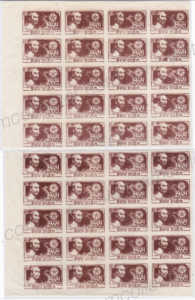
When these stamps were issued the Viet Minh controlled only parts of North Vietnam, mostly the highlands in Tonkin bordering China. Also, the Viet Minh were constantly on the run pursued by the French Army who wanted to defeat them. As a result the territory these stamps could be used was constantly changing and primarily limited to small towns or the country side which was under Viet Minh control. Postal volume in the country has always been just a fraction of that in large cities and therefore obtaining postally used stamps is much more challenging than mint ones. It took the editor more than twenty years to assemble the five postally used values below.
Rare piece of the 200D stamp orange-red imperforated together with the 50D on 5D double over-print error.
Please note that a larger quantity of cancelled to order specimens exist especially of the 100 Dong values imperforated. These are still much rarer than the mint version but by far not as rare as the postally used ones. You can recognize them fairly easily as they all carry a standard Hanoi date canceller and are always struck once on a block of four. So one stamp only shows a quarter of the cancel as can be seen below.
Given the challenging circumstances of the production of these stamps errors do exist. Below is a regularly occurring plate error in which the “V” in the word “Vietnam” is broken. It can be found in position I 3 once per sheet.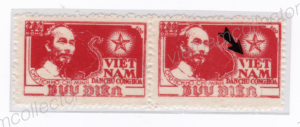
There are also cases in which the image only got printed partially. This is actually a plate fault that reoccurs on multiple sheets. Take a look at the bottom left stamp in these two blocks of four. One in the orange-red and one in the carmine color.
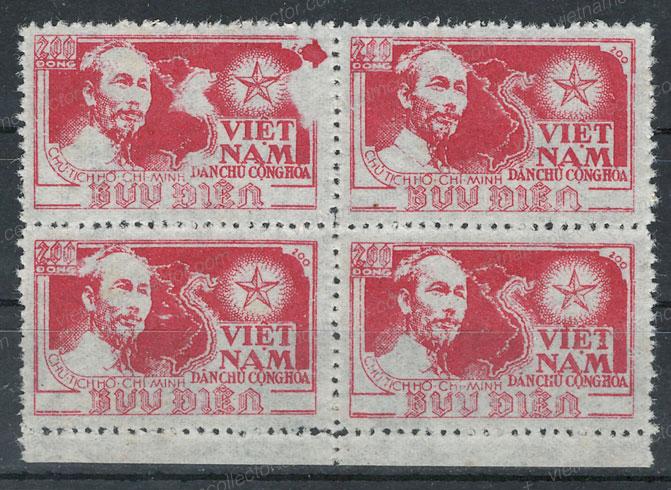
Here is a spectacular error in which the entire corner of the bottom right stamp is missing. This did not occur through a folded paper sheet but by a large object that had fallen on the sheet during the printing process.
Perforation errors occur fairly frequently. This was caused by the primitive manual perforation process described above. In this block six the vertical perforation on the right block of four is missing:
Block of four in carmine color imperforate on the right side.
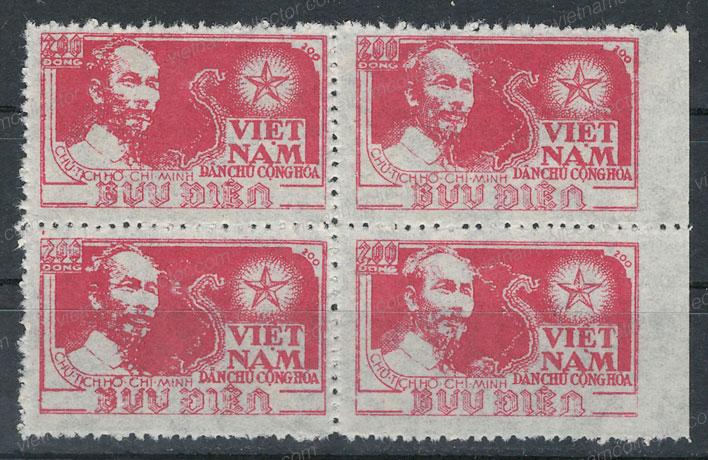
Here is a mint pair on which the horizontal perforation is missing.
Here is the 100 Dong value green imperforated at the right margin: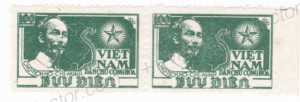
Below is a block of four of the 100 Dong value green imperforated at the top margin: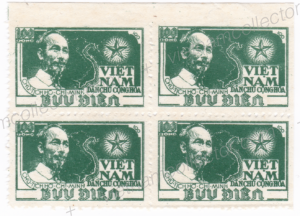
Another block of four of the 100 Dong value that is perforated 11.5 at the bottom but otherwise imperforated.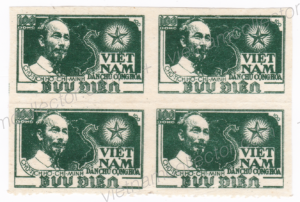
Here is a block of four of the 100 Dong value brown imperforated at the bottom margin: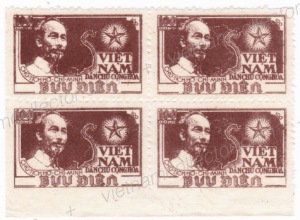
Here is a mint blok of four of the 100D value brown imperforated at the top margin:
Mint block of four imperforate on the right.
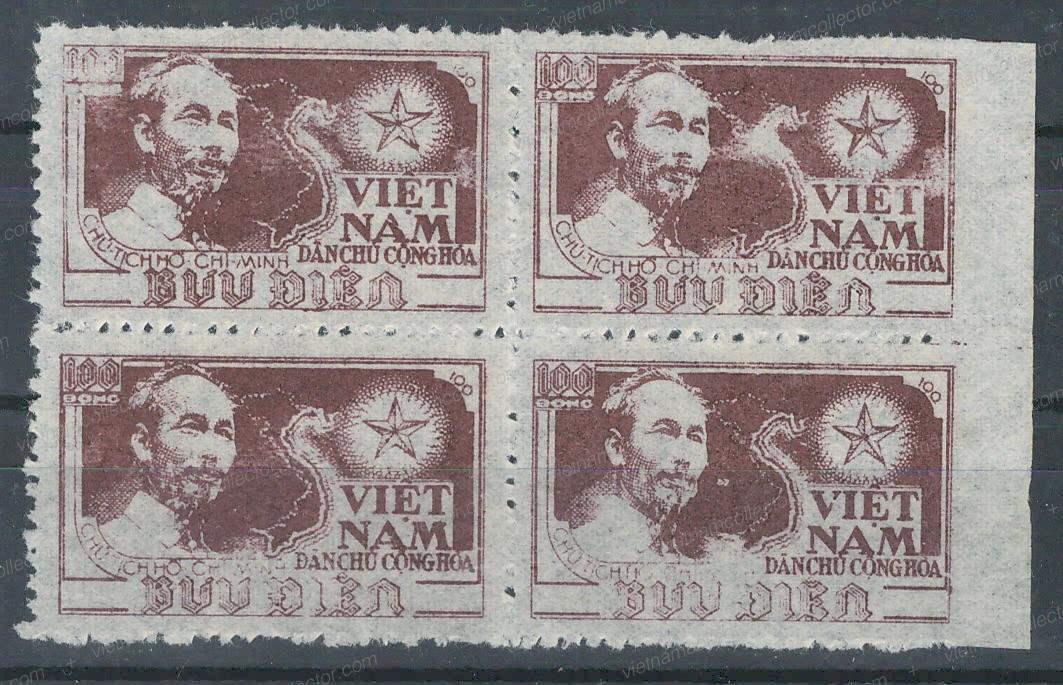
Single mint stamp which is imperforate on top and on the right.
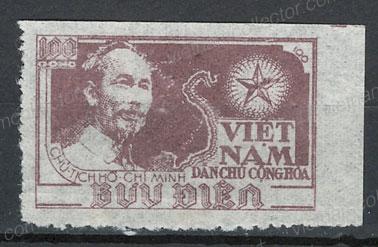
Block of six of the 100D value brown imperforated. The upper left and middle right stamp were affected by a paper fold that actually separated the paper. The middle right stamp was stamped with “Hong” which means “Damaged”. As paper was scarce the printing works delivered sheets with faulty stamps but intended them to be removed from sale by applying the “Hong” stamp.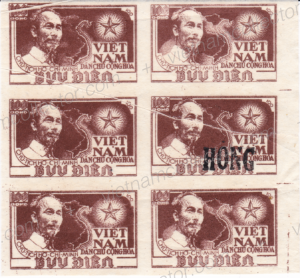
Here is a mint pair of the 100D value brown from the lower right sheet that is affected by a paper-fold that apparently was not caught by quality control:
Here is an imperforate pair on which the upper stamp shows a production flaw.
Detailed scan of the affected area.
The paper of this issue was very thin, almost like cigarette paper. As a result paper folds do occur. Here is an example: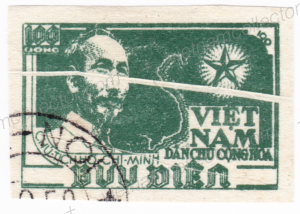
Rare complete sheet of one hundred 200 Dong stamps red-brick issue. For technical reasons the editor can only display the top 80% of the sheet but it is complete with all margins intact. Please note the small imperfections in stamp appearance in position A3 (3 stamp from the left, top row) which shows a wide dot to the left of HCM’s mouth or position G7 where the name “Viet-Nam” is partially omitted. These small imperfections are pretty typical for this issue and they do not justify higher prices. The broken “V” error in “Viet-Nam”, which occurs once per sheet, is located on position I 3 (not on the scan).
Dangerous forgeries exist of all three stamps. They are usually offered imperforated and they can come with fake “TT” overprints, cancelled with fake cancels or even on complete letters such as the one below: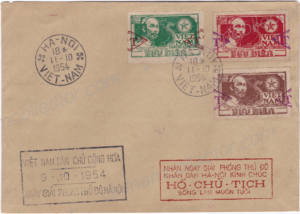
Everything with this letter is a forgery: the stamps, the “TT” overprints, the cancels and the two cachets. Here are some detail views: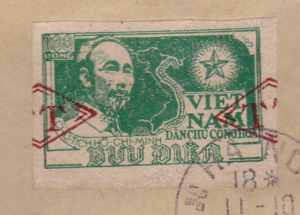
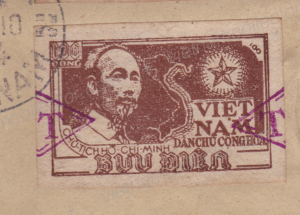
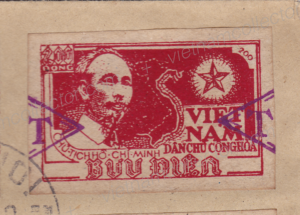
The forgeries of the stamps are remarkably well done though as is typical for forgeries the details are a little bit more fuzzy than on the originals. This is especially true for the smaller letters. They are more filigrane on the originals and bolder on the fakes. The forger produced one plate for both 100D values and another for the 200D value. A tell-tale of the 100D fakes is that the bottom of the “C” in “CHI” is curved a little bit more upwards than on the originals. The color on the 200D value is a lot deeper red (even if compared to the carmine version of the stamp) than on the originals.
The cancel and all the cachets that has been used to produce this letter all have to be considered as compromised and any cover that bears them has to be considered with a high degree of suspicion:
Beware of stamps that were cancelled far removed from the issue date. Below is a letter that was clearly philatelically inspired and was probably intended to fool less sophisticated collectors. It carries four of the green 100 Dong stamp. The top right stamp was surcharged with the 10 Dong Ngan Hang (New Dong of the National Bank, issued in 1954) in blue. The overprint represents an error as the new value was supposed to be applied at the bottom right and not top right as is the case here. The bottom two stamps are surcharged with 10 New Dong in black using the Type II (1 with a flag) overprint. Given the devaluation of the Dong in 1951 (10:1) and 1959 (1000:1) the actual postage on this cover represents 0.04 Dong (100 Dong divided by 10 and then divided by 1,000 plus 30 New Dong divided by 1,000). The cover was cancelled in Hanoi on February 1, 1972 when the standard letter rate was 12 xu or o.12 Dong. Therefore the letter is under-franked by two thirds. Since no postage due marker was applied on the cover it is clear that it just represents a late favor cancel and not postal usage. Nevertheless due to the error stamp still a rare item.
Postally used covers with these stamps are exceedingly rare. Below is a cover that was supposedly mailed on September 27th, 1953 from Hanoi to the Ethnographical Institute, Tscheremuschkinskaja in Moscow. The cover carries a Moscow arrival cancel on the reverse. If it were genuine, this would represent one of the earliest North Vietnam covers mailed abroad. According to the official UPU website (www.upu.int) Vietnam joined the Universal Postal Union (UPU) on October 20th, 1951. This however, only applied to the South Vietnamese regime that was internationally recognized by most countries at the time. North Vietnam did not join the UPU until July of 1954, when the Ho Chi Minh Government became internationally recognized after the Geneva Conference. However, the Soviet Union, China and a number of Eastern European countries recognized the Ho Chi Minh Government already in January of 1950 or within a few months thereof which means from that date on international mailings to those countries were possible. The earliest letter sent to Klewitz in West Germany dates from July of 1953. China and the Soviet Union recognized the Viet Minh Government in January of 1950 so from a pure technically point of view the HCM stamps could have been accepted for transport through China to the Soviet Union even without any UPU membership. The Klewitz letter from July 1953 would appear to document this, though also this letter lacks any Soviet or East Berlin transit or Fulda arrival cancels which would provide certainty the letter actually went beyond the Chinese border region. Also, as per Desrousseaux (SICP Journal from November, 1973, Volume 3 Nr. 5) the Chinese Communist reached the North-Eastern frontier of Tonkin in early 1950. With the French withdrawing from Cao Bang and Lang Son the connection between Vietnam and China became very easy. “Thus it’s post, until then local , may have become international”. But until now we are still looking for a genuine sample whose transit route is properly documented by transit and arrival cancels.
Upon closer examination it turns out that the letter is a forgery. The stamp is genuine but the cancels are forged or misused. This was uncovered by the small red logo of the North Vietnam Telecom Authority on the back of the envelope. The logo was designed only in the second half of 1959 so did not exist in 1953 when the letter was purportedly mailed. This means that a circular bridged date canceler from Hanoi was either forged or, more likely, got into the wrong hands and is now being used to produce forged postal history. So, any postal history that involves this particular canceler has to be closely questioned
From the same correspondence, as the letter above, stems a letter franked with a perforated version of the 200 Dong brick-red that was mailed in Tuyen-Guang, Tonkin on May 1, 1951. The town is located northwest of Hanoi in the mountains and was at that time already controlled by the Viet Minh. Some SICP members have speculated that the 200D value was first issued in 1952 (www.histoire-et-philatelie.fr) which hence could not have been used already on this letter in 1951 but that cannot be true as all three values were still issued in “Old Dong” that was devalued later on that year by 10:1. Since the 200D stamp, along with the brown and green 100D stamp was overprinted in Dong Ngan Hang currency in October of 1954, it is clear that all three stamps were issued in the same “Old Dong” currency. However, the letter is also addressed to the Ethnographical Institute, Tscheremuschkinskaja in Moscow as was the forged letter shown above. This makes it suspect simply by guilt of association. The cancel is also unusual as the lower part of the cancel has been removed. The canceller might have been an old indochinese canceller which was altered to make it suitable to the new regime or to make a forgery more believable. The domestic standard postage at the time was 40 Dong. Nothing is known about the international rates in 1951 as there was basically no international mail from North Vietnam then. The other known surface mail from North Vietnam to West Germany (though officially addressed to East Germany) mailed in July of 1953 was also franked with 200D but this letter is missing any Soviet or East Berlin transit cancels so one cannot be sure that it was transported beyond the Chinese border region.
At this point one has to assume that this second letter comes from the same forgery shop as the one above franked with the green 100D stamp. This means collectors should be extremely careful with the Tuyen-Guang cancel that was used. If it is used on others postal history, especially with the lower insert of the cancel missing, collectors should be especially weary.
Multiple franking of the brick-red 200D value (5) paying an overall postage of 1,000D on a homemade adversity cover that was fashioned out of a previously used accounting sheet. The letter was mailed from Ha Binh, south of Hanoi, addressed to the Government in Viet Bac. Illegible date cancellers. The 1,000D domestic letter rates was in force between February of 1953 until the end of June of 1953 (when it was converted to 100 Dong Ngan Hang which was the equivalent of 1,000 Dong Duong) so the letter can approximately be dated based on the postage. Sold by Gaertner Auction House as ex Klewitz which is likely as Klewitz had very high level Government contacts to the HCM Government and was able to obtain a number of official mail from his source.
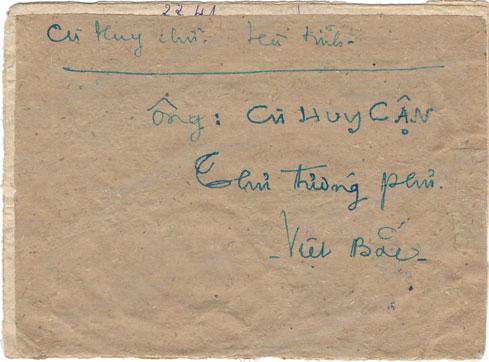
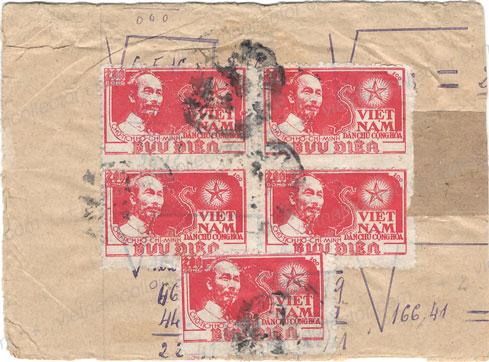
Registration Nr. 100025

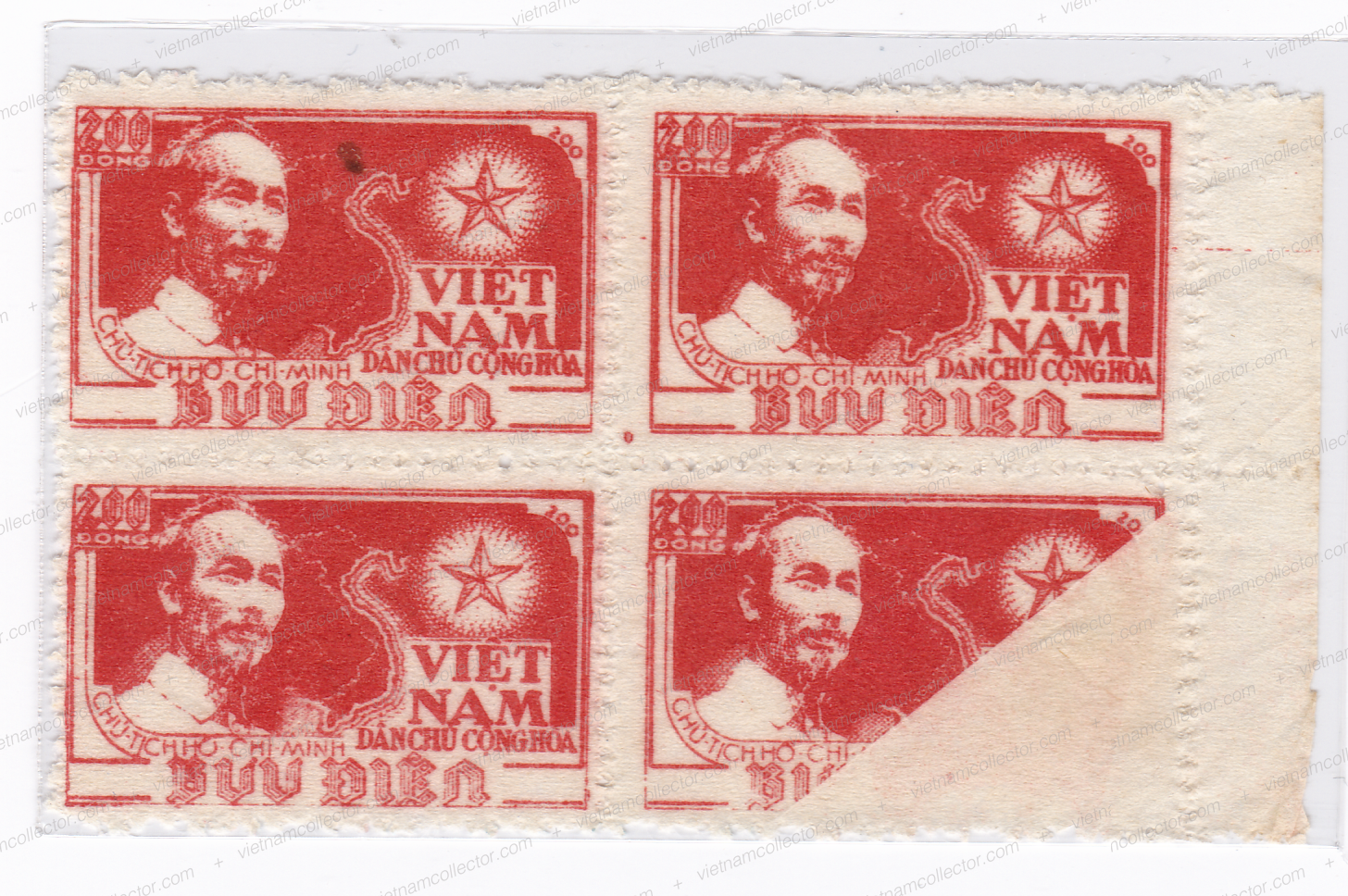
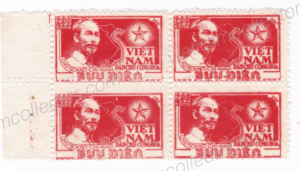
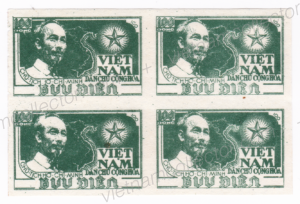
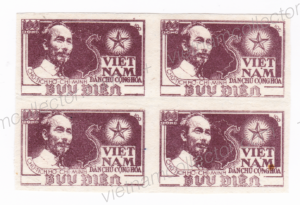
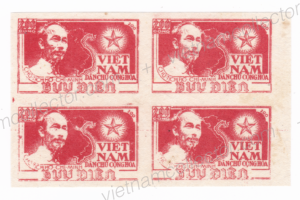
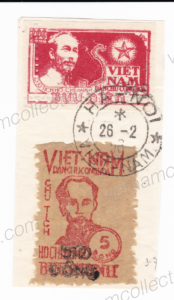
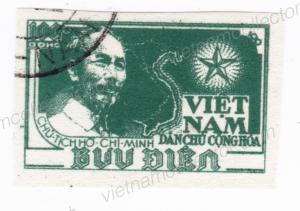
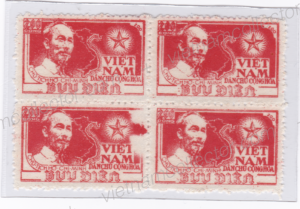
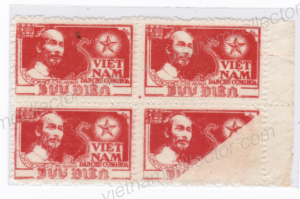
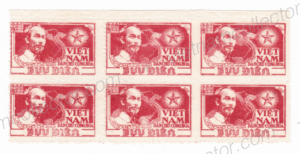
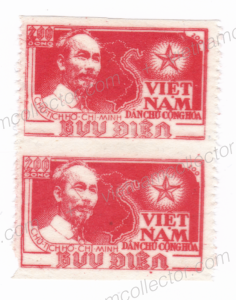
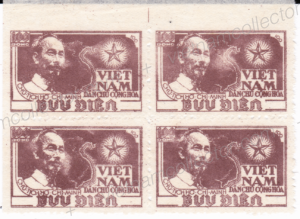
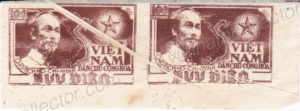

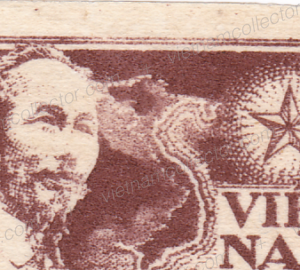
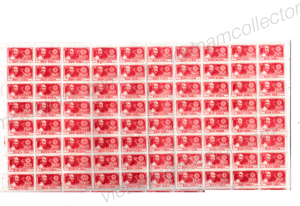
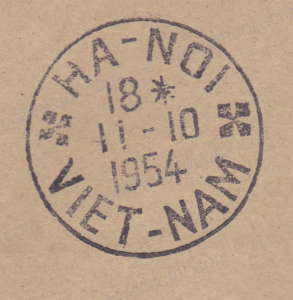
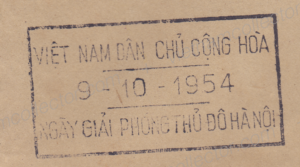
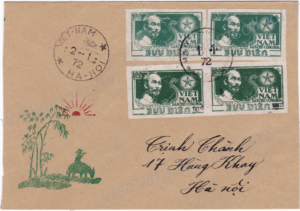
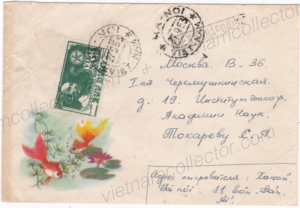
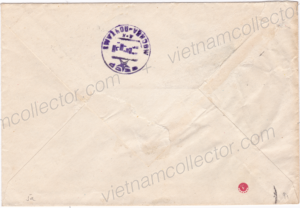
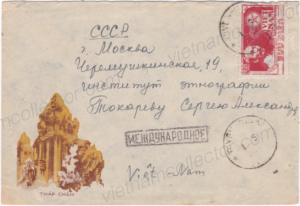
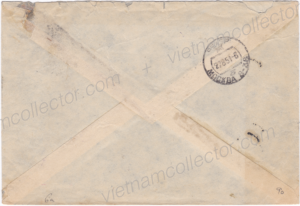
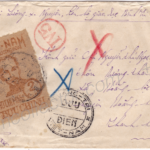
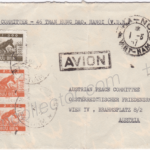


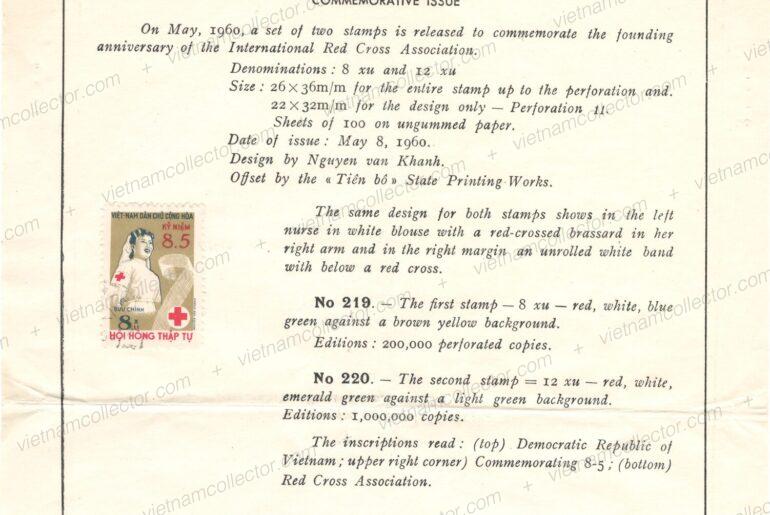
Comments are closed.